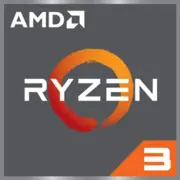AMD Ryzen 3 5300G (OEM Only)

AMD Ryzen 3 5300G (OEM Only): Budget APU for Compact Systems (April 2025)
Key Features: Zen 3, 7 nm, and Integrated Graphics
The AMD Ryzen 3 5300G, released in 2021, remains a popular choice for budget builds due to its favorable price-performance ratio.
Architecture and Process
- Zen 3: This architecture provides a 19% IPC (instructions per cycle) increase compared to Zen 2, which is important for gaming and single-threaded tasks.
- 7 nm FinFET (TSMC): The energy-efficient manufacturing process allows for 4 cores and 8 threads within a TDP of 65 W.
- Cache Memory: The 8 MB of L3 cache is modest but sufficient for basic tasks.
Performance and Key Features
- Base/Boost Frequency: 4.0 GHz / 4.2 GHz. In Cinebench R23 tests, the processor scores around ~5800 points in multi-threaded mode, comparable to the Intel Core i3-12100.
- Radeon Graphics: The integrated Vega 8 graphics (8 cores, 1700 MHz) deliver 30-45 FPS in games like CS:2 (1280×720, low settings) or Fortnite (720p, Medium).
- OEM Status: The processor is officially supplied only to system builders (Dell, HP), but is available on the secondary market (price: ~$90–$110 in 2025).
Compatible Motherboards: AM4 Socket and Chipsets
The Ryzen 3 5300G uses the AM4 socket, which provides access to a wide range of motherboards.
Recommended Chipsets
- A520: A budget option (e.g., ASUS Prime A520M-K, ~$70). Suitable for office PCs but does not support overclocking.
- B550: Optimal choice (MSI B550M PRO-VDH WiFi, ~$120). Features PCIe 4.0, USB 3.2 Gen 2, NVMe support.
- X570: For enthusiasts (Gigabyte X570 Aorus Elite, ~$150), though excessive for the 5300G.
Features:
- BIOS updates may be required for motherboards released before 2021.
- Mini-ITX boards (ASRock B550M-ITX/ac, ~$130) are suitable for compact builds.
Memory: DDR4 and Dual Channel Mode
- Memory Type: Only DDR4 (DDR5 support is absent).
- Recommended Frequencies: 3200–3600 MHz for optimal APU performance.
- Configuration: Using two modules (e.g., 2×8 GB) is essential to activate dual-channel mode, which is critical for integrated graphics.
- Tips: For gaming with iGPU, choose memory with low timings (CL16). A minimum of 16 GB is required for modern tasks in 2025.
Power Supply: Power Calculation
With a TDP of 65 W, the Ryzen 3 5300G is not demanding on the PSU:
- System with iGPU: A 350–450 W power supply is sufficient (e.g., be quiet! System Power 10 450W, ~$55).
- With a Discrete GPU: If an upgrade is planned (e.g., Radeon RX 6600), choose a PSU rated at 550–650 W (Corsair CX650M, ~$80).
Important: Cheap PSUs without an 80 Plus certification may operate unstably under load.
Pros and Cons of the Ryzen 3 5300G
Advantages
- Energy Efficiency: Consumes up to 45 W at idle.
- Integrated Graphics: A replacement for entry-level discrete GPUs.
- Price: One of the most affordable APUs on AM4.
Disadvantages
- 4 Cores: Multitasking is limited (streaming + gaming = lag).
- OEM Restrictions: No warranty when purchased second-hand.
- No PCIe 4.0: Utilizes PCIe 3.0, which slows down new generation NVMe SSDs.
Use Cases: Where 5300G Is Relevant in 2025
1. Office PCs: Working with documents, browsers (20+ tabs), Zoom—the processor handles these tasks smoothly.
2. Multimedia: Plays 4K video in VLC or YouTube without issues.
3. Light Gaming: Minecraft, Rocket League, Dota 2 on low settings.
4. Home Server: Its energy efficiency makes it a good choice for NAS running Proxmox.
Example: A build for $400 (without monitor):
- Ryzen 3 5300G — $100
- ASUS Prime A520M-K — $70
- 16 GB DDR4-3200 — $50
- 500 GB NVMe SSD — $40
- Case + 450 W PSU — $80
Comparison with Competitors
AMD Ryzen 5 5600G
- Advantages: 6 cores/12 threads, Vega 7 with 7 cores (25% higher performance).
- Disadvantages: Price of ~$140, excessive for basic tasks.
Intel Core i3-12100
- Advantages: Higher single-threaded performance, PCIe 5.0.
- Disadvantages: Integrated UHD 730 graphics are 40% weaker than Vega 8.
Conclusion: The 5300G excels in budget builds focused on graphics without a discrete GPU.
Practical Building Tips
1. Cooling: The stock cooler is sufficient, but for quieter operation, consider the DeepCool GAMMAXX 400 V2 (~$25).
2. Case: Choose models with ventilation (Fractal Design Focus G Mini, ~$60).
3. BIOS: Check the version before installing the processor (use Flashback if there is no display).
4. SSD: An NVMe SSD with PCIe 3.0 (WD Blue SN570, ~$45) will speed up system loading.
Conclusion: Who is the Ryzen 3 5300G Suitable For?
This processor is an ideal choice for:
- Budget Users: Building a PC under $500 with easy upgrade potential.
- Offices and Educational Institutions: Reliability and low power consumption.
- Enthusiasts of Compact Systems: Mini-PCs for the living room or kitchen.
Why in 2025? Despite the release of the Ryzen 8000G, the 5300G remains a cost-effective option for those who don’t need the latest technologies but value price and minimalism.
If you're looking for an APU for undemanding tasks without overspending, the Ryzen 3 5300G is still relevant. However, for gaming or working with 3D models, consider the Ryzen 5 8600G or Intel Core i5-14400.
Basic
CPU Specifications
Memory Specifications
GPU Specifications
Miscellaneous
Share in social media
Or Link To Us
<a href="https://cputronic.com/en/cpu/amd-ryzen-3-5300g-oem-only" target="_blank">AMD Ryzen 3 5300G (OEM Only)</a>